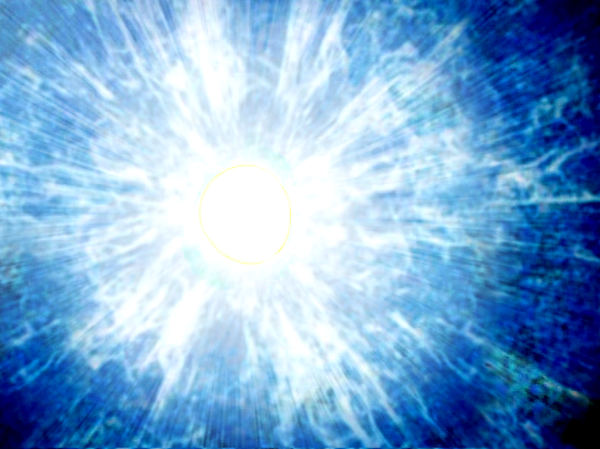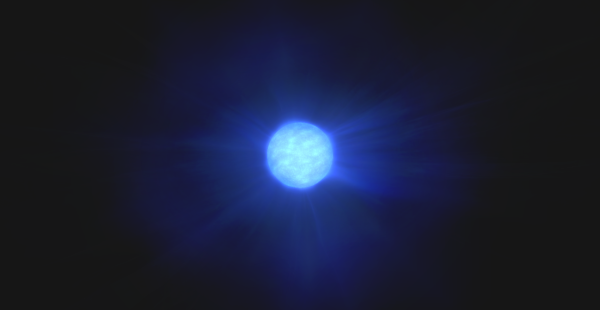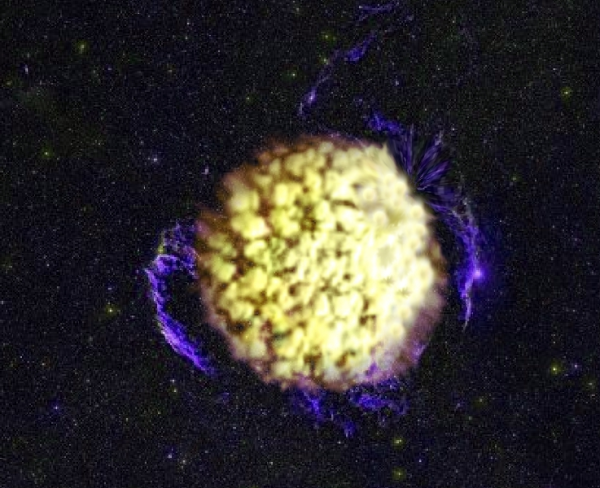BY LETTER
Muora
History > 7800 to 9999 AT: Outer Volumes Era > 7800 to 9999 AT: Age of Expansionist New Empires
Science > Astronomy
Galactography > Regions of Space > Outer Volumes
Galactography > Other Major Polities, Empires, and Meta-Empires > Sagittarius Transcultural Cooperation
Science > Astronomy
Galactography > Regions of Space > Outer Volumes
Galactography > Other Major Polities, Empires, and Meta-Empires > Sagittarius Transcultural Cooperation
Muora - WR 111 - A Supernova Event | |
 Image from Steve Bowers | |
| The Muora explosion, shortly after the r-process nucleosynthesis event | |
| Names | WR 111, HD 165763, HIP 88856, YTS 334-010-01 |
|---|---|
| Location | Sagittarius, near GN 18.05.6 |
| RA | 18h 08m 28 |
| Dec | -21deg 15'11 |
| Distance from Sol | 5320 ly |
| Luminosity | The Luminosity of Muora changed from 250,000 x Sol when first observed to 340,000 x Sol just before it finally exploded |
| Spectral type | Originally WC5, but changed to WO2 when it collapsed. Muora was a Wolf-Rayet star that exploded in 8684 AT (Averaged Nexus Time Frame of Reference), 9544 AT (Averaged Galactic Standard frame of reference). |
| Mass | 13.3 x Sol when first observed, this figure declined to 12.3 x Sol shortly before it collapsed |
| Temperature | Just befoire collapse this star had a temperature of 179,000 K |
| Radius | approx 0.6 x Sol (the radius significantly fluctuated over the period of observation, and was often obscured by the dense stellar wind) |
WR111 was one of the closest Wolf-Rayet stars to Sol, and one of the primary supernova candidates in the local galactic environment. This star was located near to the nebula GN 18.05.6 and the bright stars HD 165516 and V4381 Sagittarii, but these stars are not associated in origin with WR111 (or with each other). Astronomical observations from the Terragen Sphere determined that WR111 was likely to explode in the next few thousand years, an estimate which had been refined in the ComEmp Period to around 9550 AT (as measured using the Galactic Standard Time Frame of Reference, a timekeeping standard that uses the averaged emissions from an array of pulsars throughout the galaxy.)
 Image from Trolligi | |
| Muora was a very luminous Wolf-Rayet star when first observed, emitting a very strong and massive stellar wind | |
In 6664 AT the Sagittarius Transcultural Association agreed to send a longshot exploration mission towards WR111, which they now renamed Muora. This craft (the Golden Arrow) would carry with it a communications wormhole massing ten million tonnes, with a very low bandwidth of less than a gigabyte per second. By setting off from the Tunh Far Station, and travelling at around seventy percent of the speed of light, the Arrow and its wormhole would arrive at Muora in 9535 AT (as measured in the Averaged Galactic Standard frame of reference, adjusted for STC standards). However the ship would be able to send messages back to the Tunh Far Station which would arrive in 8675 AT (as measured by the averaged Nexus Time Frame of Reference). This would allow the explosion of the star to be observed at close hand, with results relayed back to the Terragen Sphere from the global future (without, of course, any theoretical risk of creating a temporal paradox).
This journey would take 2011 years as measured on the ship's internal clock, and 2871 years as measured externally. As the craft (which carried an S:2 controller, several S:1 subminds and a dozen virtual modosophont observers) approached the distant Wolf-Rayet star, its developing evolution could be watched in accelerated time (thanks to time dilation and ordinary Doppler effect, the star appeared to be evolving at twice its true rate). During this period, the star displayed some minor irregularities, which suggested that it would actually detonate in the year 8684 AT (Nexus Time), slightly earlier than anticipated. This gave the explorers only nine years to observe the process from a suitable distance, and of course no time at all to carry out any form of stellar husbandry. They decided to approach the star to within a hundred AU then back off to a safer distance for the explosion. The star was surrounded by a dense nebula created by the ferocious stellar wind radiating in all directions, making detailed observations difficult.
On arrival in 8675 (Nexus Time), they detected (with difficulty) another craft of unknown origin. This craft did not conform to any known Terragen Design, even those utilised by the various non-Sephirotic Empires (several commentators were expecting a Panvirtual or Transcend craft to get there first, or perhaps a probe from the Diamond Network). But this was none of those. The craft did not seem to notice the Golden Arrow, and their attempts to contact it went unanswered. But the region around the craft seemed to be unusually saturated with neutrinos, as if the craft was emitting or reflecting them back towards the swollen star.
Shortly before the expected detonation this mysterious craft withdrew at remarkable speed, and the sensors of the Golden Arrow could no longer observe it. The Arrow also withdrew, reaching a distance of half a light year, which was judged to be a safe distance taking into account the potential for damage to their craft, which was robust and capable of self-repair, but not invulnerable.
The Explosion
Muora exploded in 8684 AT (as measured in Nexus time; measured in averaged Galactic time, the date was 9544 AT). The first indications of the collapse was a massive burst of neutrinos, which were generated deep within the star as its iron core collapsed under its own weight. The core collapse was halted when the infalling material became as dense as an atomic nucleus, and finally the neutrinos could escape, taking with them a significant fraction of the star's mass-energy. If the Golden Arrow had been much closer, this burst of neutrinos would have been sufficiently powerful to denature all its computronium and kill it.Astronomers in the Terragen Sphere had by this time observed countless millions of supernovae events around the visible universe, and knew with reasonable accuracy what might have been expected to occur; some Wolf-Rayet stars collapse directly into black holes at this stage, and much of the energy of the explosion is absorbed in the process. Muora was not expected to behave like that, since it was not massive enough; but the star's collapse was significantly more asymmetrical than expected, and the shockwave that emerged from the star in due course was not quite spherical. Some observers have suggested that this may have been caused by the mysterious spacecraft that was observed near the star in the final moments, which seemed to have some method of affecting or reflecting neutrino densities.
As the shockwave finally emerged from the star it accelerated to 25% of light speed and compressed the surrounding nebula, creating by a very rapid burst of r-process nucleosynthesis a wide range of neutron-rich heavy isotopes, a process that absorbed some of the vast energies of the explosion. The shock front spread out from the explosion propelling these elements outwards, as well as the (much more abundant) elements created in the star shortly before the detonation. Three separate clouds of iron were ejected at speed in different directions, embedded in clouds of silicon, oxygen and nitrogen, each of which expanded at slightly different rates due to their relative densities.
At first the luminosity of the ejecta around the star was so brilliant, nothing could be seen via electromagnetic radiation, although the neutrino emissions showed that complex movements were occurring near the centre of the event. Eventually it was possible to see that a neutron star of 1.8 solar masses had formed, and had been ejected at 600 km/s by the asymmetry of the explosion. Perhaps significantly, this object was ejected in a direction which was almost exactly opposite to the former location of the mysterious spacecraft, strengthening the likelihood of a causal link between these events.
Over the next half year the shock wave spread out, now slowing to 10%c, while the Golden Arrow moved somewhat closer to the expanding masses of newly synthesised elements. Spreading powerful magnetic fields, the Arrow began to collect this matter for analysis and as a source of potential resources. Many highly radioactive isotopes were present, rapidly decaying into other, more stable elements. Dispersing into several widely spaced segments, the Arrow began to sample the expanding cloud from numerous angles. No further sightings of the mysterious spacecraft were made.
Aftermath
Using the fantastic energies of the supernova, the Arrow's transapient controller expanded the tiny comm-gauge wormhole significantly to increase the available bandwidth for communication with the rest of the Terragen Sphere. However, because of limitations on its metric geometry, the comm-gauge 'hole could not be expanded into a fully traversable wormhole. Full contact would have to wait for another three hundred years, when a STC linelayer would arrive.During this time the numerous, separated segments of the Arrow utilised captured matter to increase their own mass and complexity. Soon these sub-units were each as large and complex as the original, and were capable of further bifurcation. The shock wave of the supernova slowed down further, reaching 0.005c after ten standard years, allowing the fleet of Arrows to construct even more infrastructure. By the time the STC linelayer arrived, the Muora supernova remnant was home to a large and rapidly-evolving cloud of processing nodes, matter collection arrays, and monitoring stations, while a series of sub-units had colonised the newly-formed accretion disk around the runaway neutron star, which was emitting pulses at a very rapid rate and was enveloped in a strong and fluctuating magnetic field.
 Image from Steve Bowers | |
| The Muora Supernova Remnant, sometimes known as the Cauliflower Nebula | |
In the Current Era, Muora is at the end of one of the most distant branches of the Wormhole Nexus, with a significant temporal displacement compared to the Averaged Galactic Standard frame of reference. The supernova remnant has a population of many S:1, S:2 and newly-ascended S:3 entities, and will shortly be host to its first S:4 archailect. Most of the modosophont population of this energetic environment are God-Dwellers of various kinds, either living as embodied symbiotes and devotionals within the superstructure of the god-tech megastructures in this volume, or living as virtual sophonts in the local databases.
Related Articles
Appears in Topics
| 7800 to 9999 AT: Age of Expansionist New Empires | Astronomy | Outer Volumes |
| Sagittarius Transcultural Cooperation |
Development Notes
Text by Steve Bowers and Trolligi
additional material by James Rogers
Initially published on 26 April 2024.
additional material by James Rogers
Initially published on 26 April 2024.






